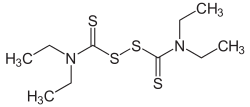| Disulfiram-like drug | |
|---|---|
| Drug class | |
 Disulfiram, the prototypical drug of this class. | |
| Class identifiers | |
| Synonyms | Alcohol sensitizers; Alcohol-sensitizing agents; Alcohol-deterrent drugs; Acetaldehyde dehydrogenase inhibitors |
| Use | Alcoholism |
| Biological target | Acetaldehyde dehydrogenase, others |
| Legal status | |
| In Wikidata | |
A disulfiram-like drug is a drug that causes an adverse reaction to alcohol leading to nausea, vomiting, flushing, dizziness, throbbing headache, chest and abdominal discomfort, and general hangover-like symptoms among others.[1][2] These effects are caused by accumulation of acetaldehyde, a major but toxic metabolite of alcohol formed by the enzyme alcohol dehydrogenase.[1][2] The reaction has been variously termed a disulfiram-like reaction, alcohol intolerance, and acetaldehyde syndrome.[3]
The prototypical drug of this group is disulfiram (brand name Antabuse), which acts as an acetaldehyde dehydrogenase inhibitor, preventing the metabolism of acetaldehyde into acetic acid, and is used in the treatment of alcoholism.[1][2] A variety of other drugs cause disulfiram-like reactions upon consumption of alcohol as unintended drug interactions and side effects.[1][2] Many disulfiram-like drugs act as inhibitors of acetaldehyde dehydrogenase similarly to disulfiram. However, some do not act via inhibition of this enzyme, and instead act via other, poorly elucidated mechanisms.
Unlike acetaldehyde dehydrogenase inhibitors and other disulfiram-like drugs, alcohol dehydrogenase inhibitors such as fomepizole (brand name Antizol) inhibit the metabolism of alcohol into acetaldehyde, thereby increasing and extending the effects of alcohol and reducing its toxicity.[4] As such, they can be thought of as converses of disulfiram-like drugs.[4] Fomepizole is used medically as an antidote against methanol and ethylene glycol poisoning.[4]
List of agents[edit]
Intended[edit]
Drugs which cause disulfiram-like reactions upon ingestion of alcohol as an intended effect include:[5]
Unintended[edit]
Drugs which cause disulfiram-like reactions upon ingestion of alcohol as an unintended effect include:[6][1][7]
- Abacavir
- Cephalosporins, but only these with a methylthiotetrazole side chain or a methylthiodioxotriazine ring; thought to be due to common N-methylthiotetrazole metabolite, which is similar in structure to disulfiram.[8] Such drugs include cefamandole, cefmenoxime, cefmetazole, cefonicid, cefoperazone, cefotetan, ceftriaxone, and latamoxef (moxalactam).[9][10]
- Chloral hydrate
- Chloramphenicol
- Ethacrynic acid
- Griseofulvin (weak evidence)[8]
- Hydrazines
- Isoniazid: causes headache via a non-ALDH2 mechanism[8]
- Procarbazine
- Ketoconazole (weak evidence)[8]
- Macrolide immunosuppressants such as pimecrolimus and tacrolimus
- Mepacrine (quinacrine)
- Nilutamide
- Nitrovasodilators (nitrates) such as nitroglycerin
- Nitroimidazoles such as benznidazole, metronidazole (disproven),[8] ornidazole.
- Pargyline
- Phenacetin
- Phentolamine
- Phenylbutazone
- Propranolol
- Sulfiram
- Sulfonamides: sulfamethoxazole likely safe[8]
- Sulfonylureas, specifically the first generation:[8] chlorpropamide, glibenclamide (glyburide), and tolbutamide
- Tolazoline
A number of drugs do not cause disulfiram-like reactions, but have other unintended interactions with alcoholic drinks. For example, alcohol interferes with the efficacy of erythromycin. Patients on linezolid and tedizolid may be sensitive to the tyramine present in tap beers and red wine.[8]
Natural[edit]
Natural compounds and species which have been found to cause disulfiram-like reactions upon ingestion of alcohol include:[11][12]
- Coprine, via active metabolite 1-aminocyclopropanol; found in mushrooms such as Ampulloclitocybe clavipes (club-footed clitocybe), Coprinus atramentarius (common inkcap), and Imperator torosus (brawny bolete) among others
- Kudzu (Pueraria lobata), conflicting evidence[13]
List of agents previously thought to cause disulfiram-like reactions[edit]
- Metronidazole[14][15]
- Tinidazole and secnidazole.[8]
- Cotrimoxazole (trimethoprim/sulfamethoxazole)[8]
- Nitrofurantoin[8]
See also[edit]
References[edit]
- ^ a b c d e John Marx; Ron Walls; Robert Hockberger (1 August 2013). Rosen's Emergency Medicine - Concepts and Clinical Practice E-Book. Elsevier Health Sciences. pp. 2398–. ISBN 978-1-4557-4987-4.
- ^ a b c d Fraser AG (1997). "Pharmacokinetic interactions between alcohol and other drugs". Clin Pharmacokinet. 33 (2): 79–90. doi:10.2165/00003088-199733020-00001. PMID 9260032. S2CID 45547473.
- ^ Mutalik, M., & Sanghavi, D. (2014). Review of Drug Interactions: A Comprehensive Update.
- ^ a b c McMartin K, Jacobsen D, Hovda KE (2016). "Antidotes for poisoning by alcohols that form toxic metabolites". Br J Clin Pharmacol. 81 (3): 505–15. doi:10.1111/bcp.12824. PMC 4767193. PMID 26551875.
- ^ Helmut K. Seitz; B. Kommerell (6 December 2012). Alcohol Related Diseases in Gastroenterology. Springer Science & Business Media. pp. 175–. ISBN 978-3-642-70048-4.
- ^ Amitava Dasgupta (17 October 2016). Alcohol, Drugs, Genes and the Clinical Laboratory: An Overview for Healthcare and Safety Professionals. Elsevier Science. pp. 77–. ISBN 978-0-12-809334-4.
- ^ Reginald Smart (22 November 2013). Research Advances in Alcohol and Drug Problems. Springer Science & Business Media. pp. 399–. ISBN 978-1-4613-3626-6.
- ^ a b c d e f g h i j k Mergenhagen, Kari A.; Wattengel, Bethany A.; Skelly, Megan K.; Clark, Collin M.; Russo, Thomas A. (21 February 2020). "Fact versus Fiction: a Review of the Evidence behind Alcohol and Antibiotic Interactions". Antimicrobial Agents and Chemotherapy. 64 (3). doi:10.1128/aac.02167-19. PMC 7038249.
- ^ Kitson TM (1987). "The effect of cephalosporin antibiotics on alcohol metabolism: a review". Alcohol. 4 (3): 143–8. doi:10.1016/0741-8329(87)90035-8. PMID 3593530.
- ^ Lewis R. Goldfrank (2006). Goldfrank's Toxicologic Emergencies. McGraw Hill Professional. ISBN 978-0-07-147914-1.
- ^ Joseph F. Ammirati (1985). Poisonous Mushrooms of the Northern United States and Canada. U of Minnesota Press. pp. 131–. ISBN 978-0-8166-1407-3.
- ^ Barry H. Rumack; David G. Spoerke (27 September 1994). Handbook of Mushroom Poisoning: Diagnosis and Treatment. CRC Press. pp. 303–. ISBN 978-0-8493-0194-0.
- ^ "Herbal Approaches to Alcohol Dependence: Evidence and Risks". Pharmacy Times. 7 December 2016.
- ^ Workowski, Kimberly A; Bachmann, Laura H; Chan, Philip A; Johnston, Christine M; Muzny, Christina A; Park, Ina; Reno, Hilary; Zenilman, Jonathan M; Bolan, Gail A (2021). "Sexually Transmitted Infections Treatment Guidelines, 2021". MMWR. Recommendations and Reports. 70 (4): 1–187. doi:10.15585/mmwr.rr7004a1. PMC 8344968. PMID 34292926.
- ^ Fjeld, Hilde; Raknes, Guttorm (16 September 2014). "Er det virkelig farlig å kombinere metronidazol og alkohol?". Tidsskrift for den Norske Legeforening. 134 (17): 1661–1663. doi:10.4045/tidsskr.14.0081. ISSN 0029-2001. PMID 25223673. Retrieved 22 February 2022.
External links[edit]
 Media related to Disulfiram-like drugs at Wikimedia Commons
Media related to Disulfiram-like drugs at Wikimedia Commons